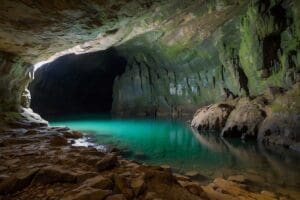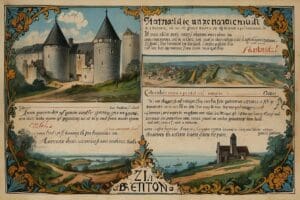Examining Irish and Japanese Folklore: Mythical Beasts Across Cultures
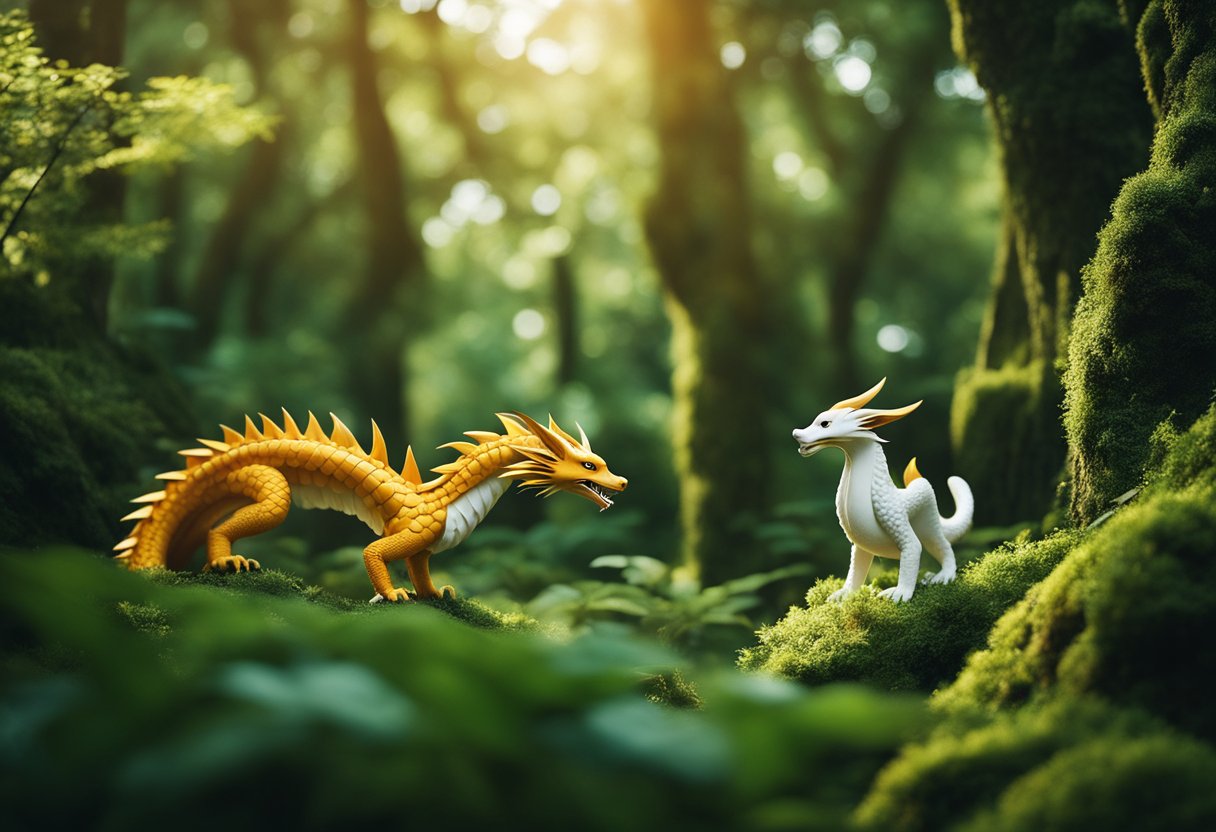
Updated On: April 16, 2024 by Maha Yassin
Mythical beasts hold a special place in the cultural fabric of societies worldwide, and a comparative study of Irish and Japanese folklore reveals a rich tapestry of legends and tales passed down through generations. Ireland’s storytelling tradition, with its pantheon of gods, warriors, and creatures, offers a unique window into the Druidic and Celtic influences on its culture. The leprechaun, for example, is a quintessential figure within Irish folklore, epitomising the enchanted nature of the Emerald Isle’s mythological heritage. Meanwhile, the vibrant realm of Japanese folklore brings forth many spirits and monsters, such as the mischievous tanuki and the enigmatic kappa, deeply ingrained in Shinto and Buddhist traditions.
In both cultures, these mythical entities are more than mere stories; they serve as metaphorical expressions of human experience, moral lessons, and complexities of nature reflected through the lens of myth. As symbols, they’ve been shaped by Ireland and Japan’s cultural and historical contexts. Understanding the similarities and differences in portraying these creatures can reveal how each culture confronts universal themes of life, death, and the supernatural.
Origins of Mythology: Irish and Japanese Folklore
In this section, we explore the roots of Irish and Japanese mythology, revealing how ancient beliefs and storytelling traditions have shaped both cultures.
Mythological Beginnings
Ireland: Our oral tradition has been pivotal in preserving Irish mythology. Stories were passed from generation to generation, capturing the essence of our cultural identity. Central to this lineage are the Tuatha Dé Danann, a supernatural race in the Mythological Cycle, which weaves together the many strands of our pre-Christian heritage.
Japan: Like Ireland, Japan values its rich folklore tradition and the otherworld. Influenced by indigenous Shinto beliefs and later Buddhism, Japanese mythology incorporates a myriad of kami (gods and spirits) that reside in all aspects of nature. The Kojiki and Nihon Shoki texts are vital to understanding Japanese mythological origins, containing creation myths and tales of divine beings.
Societal Influences
Ireland: With the advent of Christianity, our country saw the fusion of ancient Celtic beliefs with new Christian values. This blending is often crystallized in literary works, such as the iconic tales of St. Patrick and the evolution of native figures like the banshee, who adapt to fit within a Christian worldview yet retain their otherworldly roots.
Japan: Across the sea in Japan, the convergence of folklore with Buddhist philosophies and Shinto practices shaped the societal narrative. Rituals and festivals illustrate the amalgamation of mythological themes with everyday life, exemplifying the timeless influence of these tales on Japanese society.
By appreciating these origins and influences of mythological content, we gain a deeper understanding of the profound impact mythology holds within Irish and Japanese cultures.
Irish Mythological Pantheon
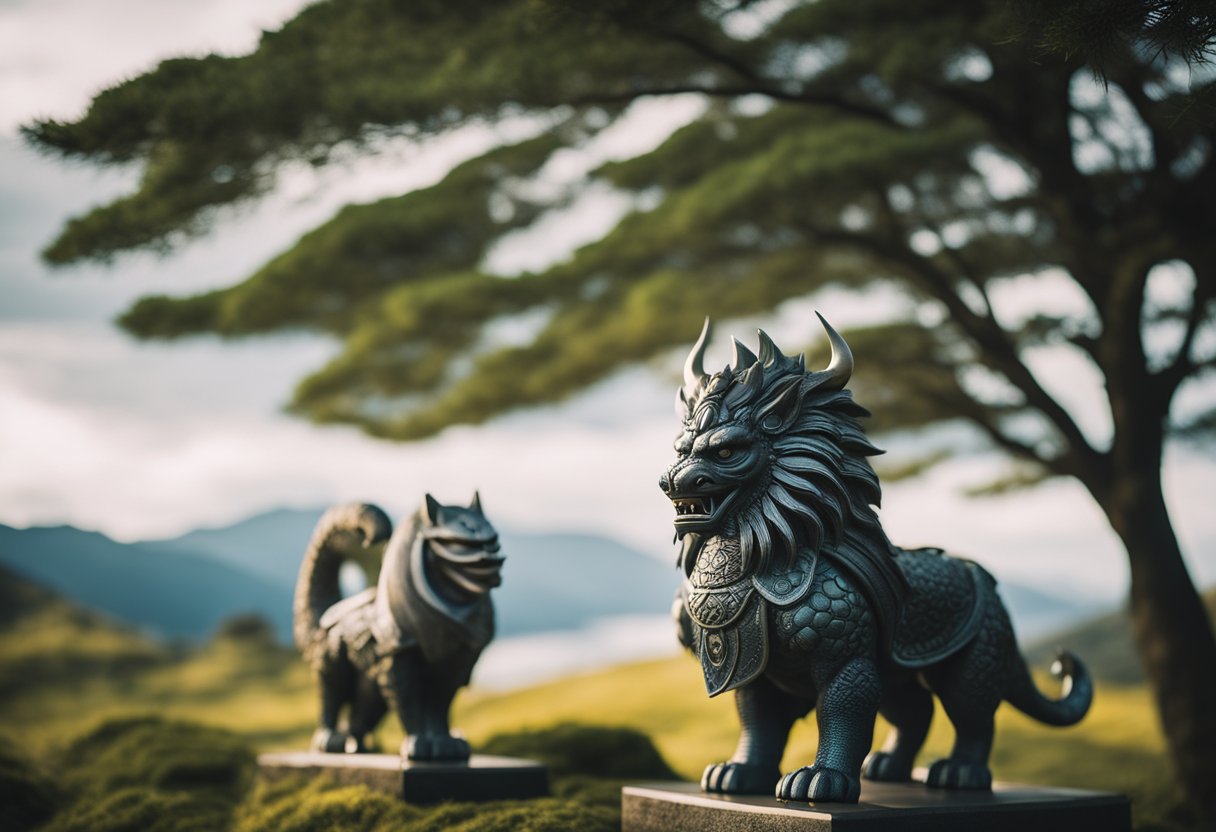
Our comprehensive examination of the Irish mythological pantheon reveals a complex tapestry of supernatural beings and mortal heroes. This mythology resonates with tales of the Tuatha Dé Danann, formidable gods and goddesses, and the Aos Sí — the spirits or fairies of ancient Ireland.
The Aos Sí
The Aos Sí, or ‘people of the mounds’, are believed to be the remnants of the Tuatha Dé Danann and ancient ancestors. These fairie folk live in the Otherworld but interact with ours through the Irish countryside’s Sidhe (fairy mounds). They are central to the lore of fairies in Ireland and are often associated with specific natural features.
Celtic Gods and Goddesses
The deities of Irish mythology largely stem from the legendary Tuatha Dé Danann, a pantheon of god-like figures who are said to have ruled Ireland before the arrival of humans. These beings were skilled in magic and craftsmanship, attributes that elevated them to a revered status among Celtic gods and goddesses. The Tuatha Dé Danann represents diverse aspects, from war and fertility to arts and knowledge.
Legendary Heroes
Fionn mac Cumhaill and Cú Chulainn stand out among Ireland’s legendary heroes. Fionn, the central figure in the Fenian Cycle, is celebrated for his wisdom and leadership. Cú Chulainn, the prominent hero of the Ulster Cycle, is renowned for his superhuman prowess and tragic destiny. These heroes’ sagas, including their courageous deeds and intricate lives, have etched them permanently into Ireland’s cultural identity.
Japanese Mythological Creatures
In our exploration of Japanese folklore, we encounter a rich tapestry of mythical creatures, each bound to the spiritual belief system of the land. Japanese mythology is populated by an array of entities that range from the benevolent kami—gods of Shinto to the mischievous or malevolent yōkai—supernatural monsters.
Yōkai and Kami
Yōkai is a central element of Japanese folklore, embodying the supernatural forces that inhabit the world. These entities often possess animal-like features, with spirits such as kitsune—the shape-shifting foxes serving as powerful messengers, and tengu—the bird-like protectors of forests and mountains.
Examples of Yōkai:
- Kappa: Amphibious demons are known for their water-bound activities.
- Tanuki: Raccoon dogs associated with trickery and shape-shifting.
In contrast, kami are honoured spirits or gods intrinsic to the Shinto religion. These revered entities can be found throughout nature, residing in trees, rivers, and mountains, and are worshipped at shrines across the country.
Significant Kami:
- Ryūjin: The dragon god of the sea, symbolising power and the ocean’s depths.
- Inari: The kami of fertility, rice, tea, and foxes, with kitsune serving as their messengers.
Learn more about the intricate relationships between yōkai and kami.
Tales of Oni and Tengu
Oni, often depicted as large and menacing ogres with wild hair and tusks, are prevalent in tales warning against malevolence. They act as punishers for the wicked or as obstacles for heroes to overcome in their quests.
Characteristics of Oni:
- Beat: Oni possess extreme strength and are often seen wielding heavy clubs.
- Appearance: Red or blue skin and a fearsome countenance differentiate them from other spirits.
Tengu stands as complex figures in Japanese folklore, once considered harbingers of war, they transformed into protective spirits. With human and avian characteristics, these mythical creatures serve as a bridge between the physical and spiritual realms. They are connected to the practice of martial arts as mentors or adversaries, imparting knowledge or challenging warriors to grow.
Traits of Tengu:
- Long Noses: Distinctive long noses are a signature feature of tengu.
- Martial Prowess: They are often attributed with exceptional swordsmanship and martial arts skills.
Discover the roles of oni and tengu in Japanese legends and folklore.
Central Myths and Folk Stories
We delve deep into the heart of cultural storytelling, exploring the myths and legends that form the bedrock of Irish and Japanese folklore. These narratives uncover the tapestries of morality, quests, and elemental humanity passed down through generations.
Signature Irish Tales
Ireland’s folklore is steeped in the Mythological Cycle and Ulster Cycle, encapsulating a world where deities, heroes, and mystical lands like Tír na nÓg intertwine. The tale of the Children of Lir, a poignant story of loss, transformation, and enduring love, is a central myth shared for centuries. These stories are not just entertainment; they often carry moral lessons that resonate with listeners and readers across time.
- The Mythological Cycle: Comprising the earliest tales of gods and origins.
- Ulster Cycle: Known for tales of heroism and the famous Táin Bó Cúailnge.
- Children of Lir: Symbolises themes of family and transformation.
- Tír na nÓg: Represents an otherworldly realm of eternal youth and beauty.
These tales serve as a cultural vessel, teaching us about the values and struggles of our ancestors.
Pivotal Japanese Legends
Japanese folklore is rich with stories that blend the natural and supernatural, often featuring quests or trials that heroes must endure. Tales from collections like the Kojiki and Nihon Shoki trace the lineage of gods and empires, while stories of spirits like Yokai reflect the fears and fascinations of the Japanese people. Love stories are interwoven with tales of loyalty and honour, exemplifying the virtues esteemed in Japanese society.
- Kojiki and Nihon Shoki: Chronicles that recount Japan’s creation and its gods’ lineage.
- Yokai: A group of supernatural creatures, each with their own story.
In telling these legends, we preserve identity and continuity, connecting us with our past and each other.
Cultural Representation Through Folklore
We find that folklore serves as a vital conduit for expressing cultural identity. This reflection is prominently seen in the Irish and Japanese cultures through the portrayal of their mythical entities and the principles they embody.
Nature and Supernatural
In Irish folklore, entities such as the banshee and the leprechaun are deeply intertwined with the fabric of nature. With her mournful wail, the banshee is believed to forewarn of impending death, showcasing a spiritual connection to life and the transition beyond. The leprechaun, a mischievous solitary creature, is often associated with the untamed natural landscapes of Ireland, guarding material wealth in pots of gold.
Conversely, Japanese folklore presents creatures like kami, spirits revered in Shinto beliefs inhabiting natural features such as mountains, rivers, trees, and rocks, revealing a spiritual essence resonating within the natural world.
Moral and Social Values
Folklore inherently conveys the moral and social values of a culture. The tales of leprechauns reflect teachings on the consequences of greed and the importance of respecting the elusive boundary between the human and the faerie realms. These narratives shape society’s attitudes towards material possessions and respect for nature’s bounty.
In Japan, spirits like kami are seen as protectors, often providing guidance and wisdom. Adhering to customs that honour these entities reflects societal values that foster respect, harmony, and morality within the community. The mythology embodies the collective consciousness and cultural interplay between society, beliefs, and the supernatural.
Festivals and Celebratory Customs
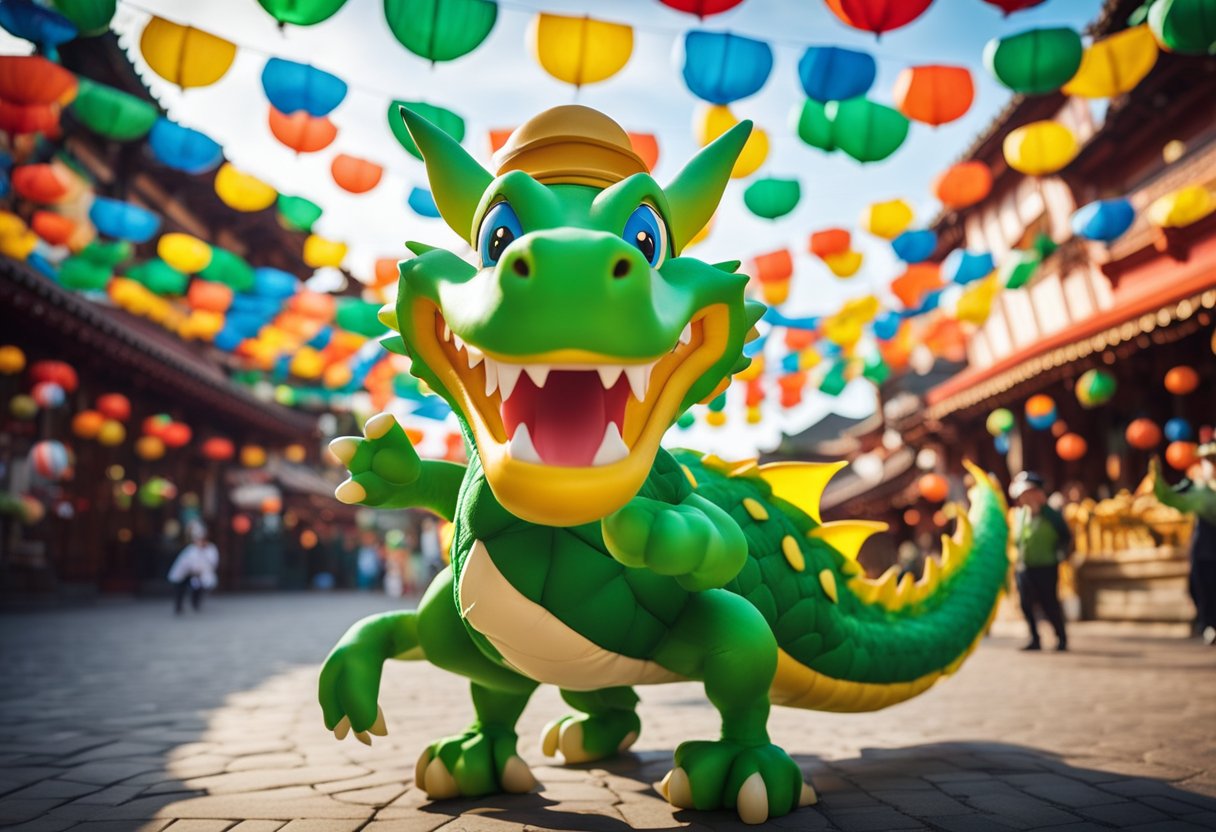
In exploring Irish and Japanese folklore, it’s fascinating to see how each culture commemorates its mythical heritage through distinct festivals and customs. These occasions celebrate the rich tapestry of their cultural mythology, strengthen community ties, and pass on traditions to future generations.
Seasonal Traditions
Ireland: One of our most revered seasonal traditions is Samhain, marking the end of the harvest season and the beginning of winter. Celebrated from 31 October to 1 November, Samhain is considered a time when the veil between this world and the Otherworld is thinnest, allowing spirits to pass through. The festival has evolved into what many know today as Halloween, with customs such as bonfires, costume-wearing, and ‘guising’ (trick-or-treating).
Japan: Conversely, Japan cherishes Hanami in the spring, a custom of enjoying the transient beauty of flowers, especially cherry blossoms. Families and friends gather under the sakura trees, holding picnics and parties to relish the blooms in parks and along rivers. This celebration is a poignant reminder of life’s beauty and fleeting nature, a concept deeply rooted in Japanese culture.
Rituals and Ceremonies
Ireland: St. Patrick’s Day on 17 March is a cultural and religious feast day honouring St. Patrick, the patron saint of Ireland. Originally a day of solemnity for the saint who introduced Christianity to Ireland, it has become a global celebration of Irish heritage and culture. Parades, wearing green, and musical events make up the vibrant festivities.
Japan: Obon, observed from the 13th to the 15th of August, is a Buddhist custom to honour the spirits of ancestors. During Obon, people return to their ancestral family places and clean their relatives’ graves. Lanterns are hung to guide spirits, and traditional Bon Odori dances are performed. The celebration concludes with Toro Nagashi, where lanterns are floated down rivers to the sea, symbolically sending the ancestral spirits back to the world of the dead.
Impact of Folklore on Modern Society
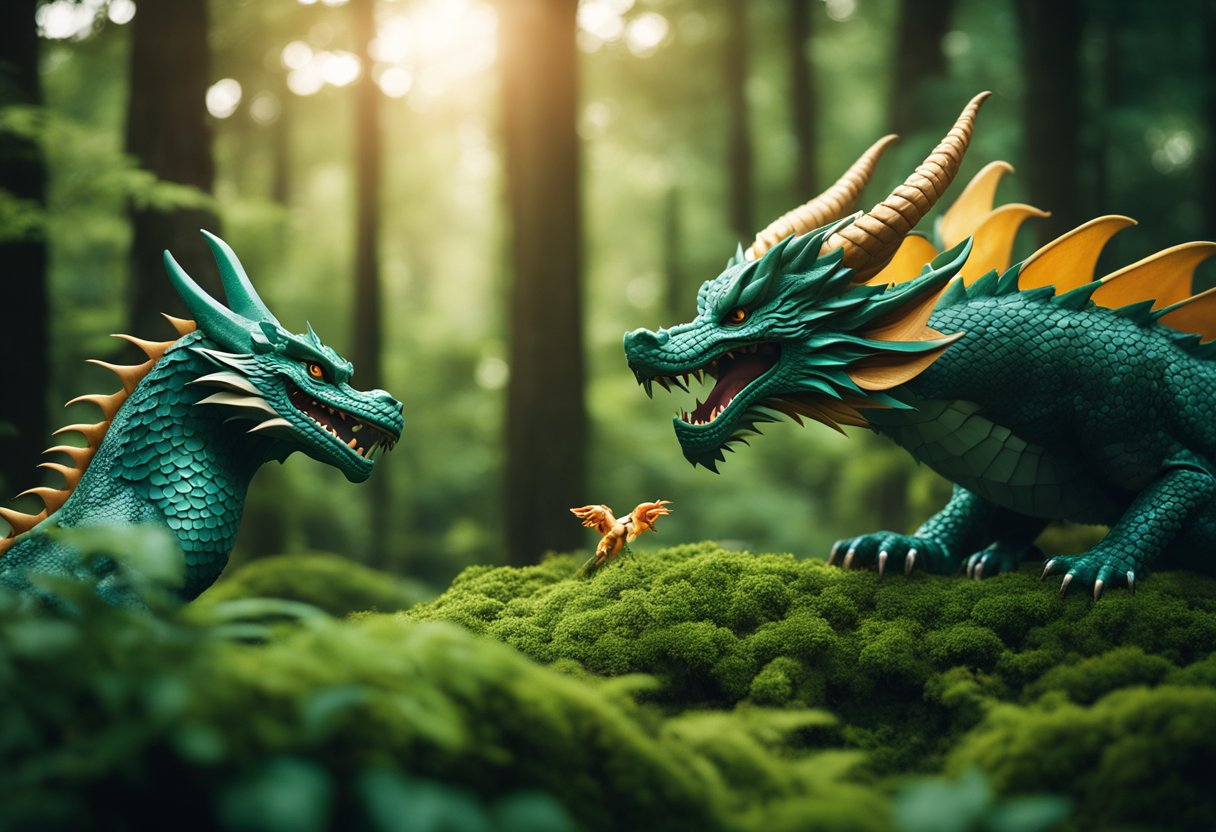
Folklore has an indelible influence on the fabric of modern society, rejuvenating traditional beliefs through literature, arts, contemporary media, and more, shaping our collective consciousness.
Influence on Literature and Arts
Folklore has long seeded inspiration in the arts, with writers and artists drawing from the well of traditional narratives and mythologies. Our literary landscape is peppered with references to mythical beings, from the mischief of Puck in Shakespearean tales to the heroic sagas within Irish folklore. The revival of such characters in modern literature underscores their timeless appeal and highlights the enduring impact of folklore.
In visual arts, the portrayal of fairies and other mythical creatures can be traced back through centuries, appearing in both classical and modern works. This artistic legacy celebrates folklore while continually reimagining it for each generation, ensuring its place within our cultural heritage.
Folklore in Contemporary Media
Modern reinterpretations of folklore are prominently featured across various facets of media. In film and television, mythological monsters and gods often leap from the pages of folklore to the screen. For instance, series like “Percy Jackson” bring Greek mythology alive to contemporary audiences, blending ancient tales with present-day settings.
Even in music and pop culture, echoes of ancestral stories can be heard, shaping the narratives and themes of songs and performances. From ghost stories to urban legends, these elements are interwoven with modern expressions, signifying our ongoing dialogue with the folklore of the past.
Preservation and Evolution of Folklore
In exploring folklore, we understand that its preservation and evolution are intrinsic to the enduring nature of mythical beasts in Irish and Japanese cultures. We’ll examine how these tales have been handed down and transformed through oral traditions and adaptations.
The Role of Oral Traditions
Oral traditions, the cornerstone of cultural preservation, have allowed stories of mythical creatures to be passed down from generation to generation. In Ireland, the ancient Sean-nós singing tradition served as a vessel for these tales, embedding them within melodies that echoed through time. Similarly, Japan’s kataribe, storytellers of old, meticulously preserved narratives of fantastical beings like tengu and kappa, ensure their place in the cultural consciousness.
Adaptations and Transformations
Folklore is not static; it undergoes adaptation and evolution. As much as archives and museums play a crucial part in preserving original folklore artefacts, new formats bring these myths to contemporary audiences. In Ireland, literature has woven creatures like the banshee and leprechaun into novels that resonate with modern values, while in Japan, manga and anime have reimagined entities like one and dragons, embedding them within popular culture.
Through this lens, cultural preservation becomes a dynamic process, keeping the essence alive while allowing stories to adapt and ensuring relevance for future generations.
Comparative Analysis: Irish and Japanese Folklore
This comparative study explores the rich tapestry of Irish and Japanese folklore, examining themes, narratives, characters and archetypes. Our analysis reveals an intriguing intersection of cultural values, moral lessons, and the use of myth to explain natural phenomena and human behaviour.
Themes and Narratives
Irish folklore often revolves around the Otherworld, a realm of mystical beings like fairies, inhabited by heroes such as Fionn mac Cumhaill. Family and community play central roles, evident in tales of unity and sacrifice. On the other hand, Japanese folklore, with stories like that of Momotarō, emphasizes values of perseverance and bravery, with heroes often triumphing over villains through cunning and moral strength. Both cultures share narratives where physical and spiritual transformation serves as a testament to the character’s growth or as a punishment for their misdeeds.
- Love and Transformation: In both cultures, tales of love often lead to transformative outcomes, sometimes quite literally, as characters may change form to overcome obstacles.
- Otherworld Journeys: Irish and Japanese tales involve journeys to otherworldly realms, challenging heroes and affecting their communities upon their return.
Characters and Archetypes
Irish and Japanese folklore are populated with various characters that embody universal archetypes. We find tricksters like the Irish Leprechaun and the Japanese Kitsune, both using their wits to challenge the status quo. Likewise, infamous villains such as Balor from Irish tales and Oni from Japanese legends represent chaos and evil that must be overcome.
- Heroes: Famed Irish figures like Cú Chulainn and Japanese samurai like Minamoto no Yoshitsune represent the valiant protector.
- Community and Family: Stories like the Japanese folktale “The Gratitude of the Crane” highlight the importance of community ties and familial responsibility.
By delving into these narratives and characters, we understand how each culture uses folklore to define its identity, convey social mores, and foster a sense of continuity across generations.
Mythical Beasts and Their Symbolisms

In exploring Irish and Japanese folklore, we uncover a wealth of meaning behind the mythical creatures that populate their tales. These beings serve as captivating components of stories passed down through generations and as rich symbols with deep cultural significance.
Creatures as Cultural Icons
Irish folklore is a tapestry woven with tales of creatures like dragons and banshees, each carrying a distinct emblematic value. Dragons often symbolise power and guardianship, looming large in Celtic myths as formidable protectors of treasures and knowledge. Banshees, with their mournful cries, are seen as omens of death, presaging the passing of a family member and representing the enduring connection between the Irish people and the spirit world.
Conversely, Japanese folklore offers us the mischievous tanuki and the watery kappa. Tanuki are shape-shifting creatures, embodying traits of humour and resourcefulness. They are frequently depicted as jovial figures capable of bringing prosperity and fortune, reflecting the Japanese appreciation for balancing the playful and the serious in life. Kappa, on the other hand, are aquatic goblins known for their trickster qualities, teaching caution and respect for the elements of water and the dangers they may conceal.
Allegories and Representations
In their essence, mythical creatures often convey lessons or cautionary advice. Leprechauns, the crafty little beings from Irish lore, represent the heart of Irish whimsy and the importance of protecting one’s valuable possessions. Their legends are steeped in the desire to seek fortune and caution against greed.
In parallel threads, Japanese myths treasure the dragon as a majestic creature associated with strength and good fortune. By contrasting the Western view of dragons as fearsome beasts, Japanese dragons emerge as benevolent entities, signalling the interconnectedness of cultural identity and the diverse interpretations of symbolic meaning across cultures.
These allegories and representations show how mythical creatures reflect their respective cultures’ identities, values, and ethos. These stories, filled with fantastical beings, offer us a deeper understanding of the world’s rich tapestry of traditions and beliefs.
Conclusion
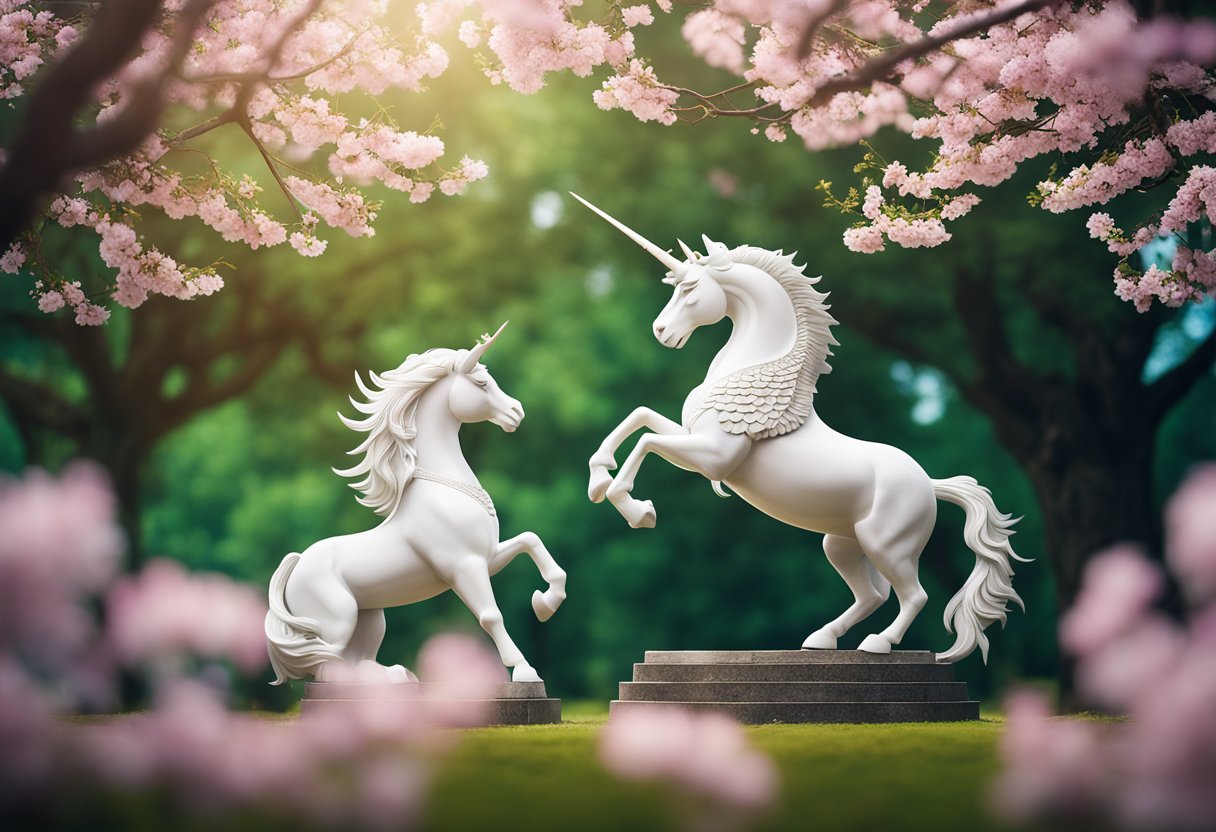
In our comparative study of Irish and Japanese folklore, we’ve uncovered insights into the mythical beasts that populate tales from both cultures. These creatures, from Japan’s shapeshifting tanuki to Ireland’s enigmatic púca, are more than mere tales; they embody their respective cultures’ values, fears, and aspirations.
Through our exploration, we’ve recognised these myths’ role in cultural exchange. It’s evident that despite the geographical distance, common threads—such as transformation and trickery—resonate with universal aspects of the human experience. This shared narrative fabric points to a profound interconnectivity of human storytelling.
Looking ahead, it is essential to continue fostering an appreciation for such rich folklore. The ongoing exchange between cultures enriches our global narrative, offering endless opportunities for reflection. As we move into the future, we ought to strive for deeper understanding, preserving and celebrating the uniqueness of our heritages while embracing their dynamic evolution and reimagining.
We remain committed to this journey of discovery. By delving into the past and sharing knowledge, we ensure the continuity and reverence of these stories. Our shared responsibility is to ensure they continue to inspire and educate for future generations.
Frequently Asked Questions
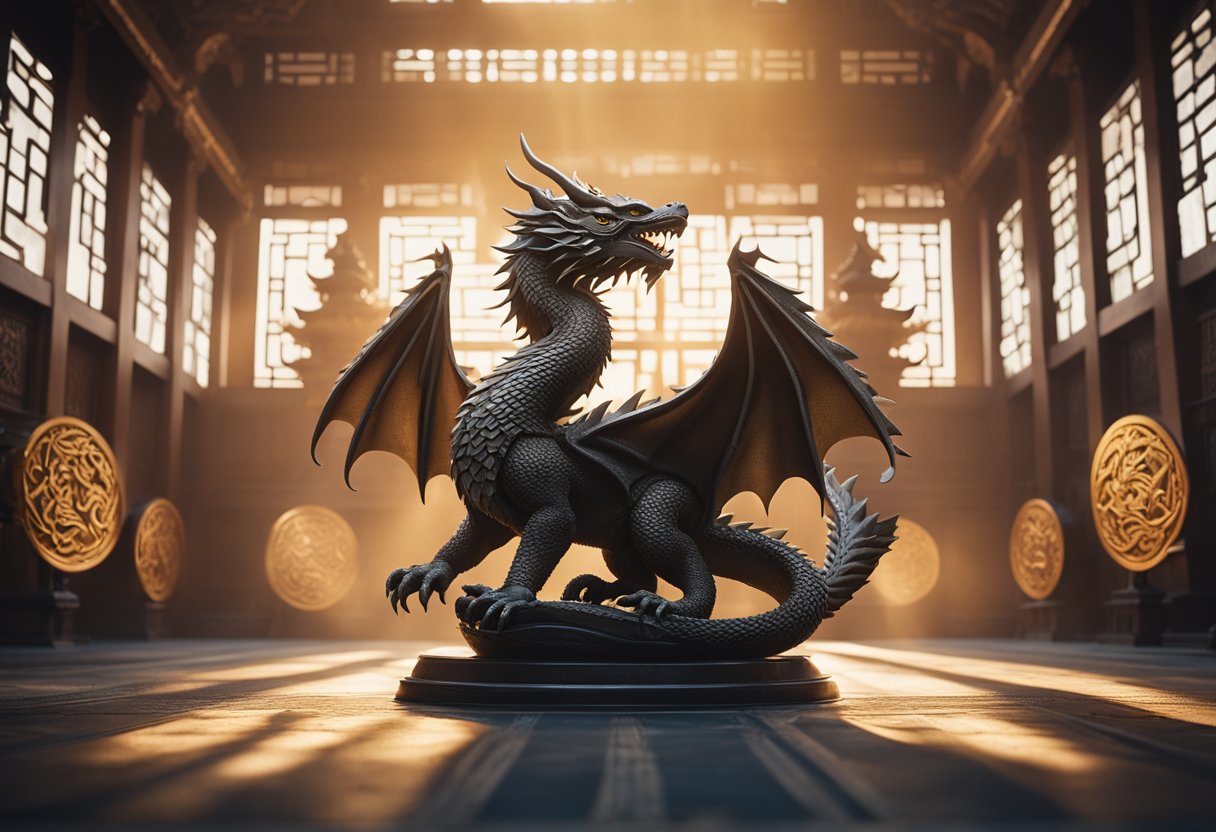
This section explores some of the most intriguing questions about mythical beasts across Irish and Japanese folklore. We delve into the distinct creatures featured in both cultures, their unique characteristics, and their roles within their mythologies.
What are the primary mythical beings present in Irish folklore?
In Irish folklore, the mystical landscape is rich with entities such as the Banshee, the wailing spirit that foretells death, and the Aos Sí or ‘Otherworld’ beings akin to fairies. Legendary creatures like the shape-shifting Púca and the fearsome Morrigan also play a pivotal role in the enchanting tales passed down through generations.
Which creatures from Japanese mythology exhibit a dualistic nature?
Japanese mythology presents beings like the Kitsune and Tengu, which possess benevolent and male traits. The Kitsune, a fox spirit, is known for its intelligence and magical abilities, often acting as a protector or a trickster. Similarly, Tengus are complex figures, sometimes viewed as protective deities and other times as mischievous entities.
How do mythical creatures from different cultures compare?
Across various cultures, we find recurring themes and archetypes, such as dragons, that embody power with varying attributes. Irish dragons are often seen as formidable creatures to be slain, as in the tale of Saint George. In contrast, Japanese dragons like Ryu tend to be more spiritual and associated with the forces of nature.
Can you name some mythical guardians from global traditions?
Mythical guardians are prevalent in many traditions, with creatures such as the Griffin, which protects treasures and priceless possessions, and the Japanese Shisa, lion-dog statues known to ward off evil spirits, embodying the concept of guardianship across different cultures.
What is considered the rarest entity in the realm of mythical creatures?
The rarity of a mythical creature often comes from its exclusive role within a particular cultural mythos. The Irish Leprechaun often sought its hidden pot of gold, and the Japanese Baku, a dream-eating chimaera-like being, could both be regarded as rare entities within their distinctive cultural contexts.
What are some instances where mythical creatures are believed to have existed in history?
Throughout history, there have been instances where mythical creatures were thought to be real. For example, the Giant’s Causeway in Ireland was believed to be the handiwork of the giant Finn McCool, and fossils found in medieval Japan were sometimes thought to be the remains of Kirin, akin to a unicorn or dragon.




